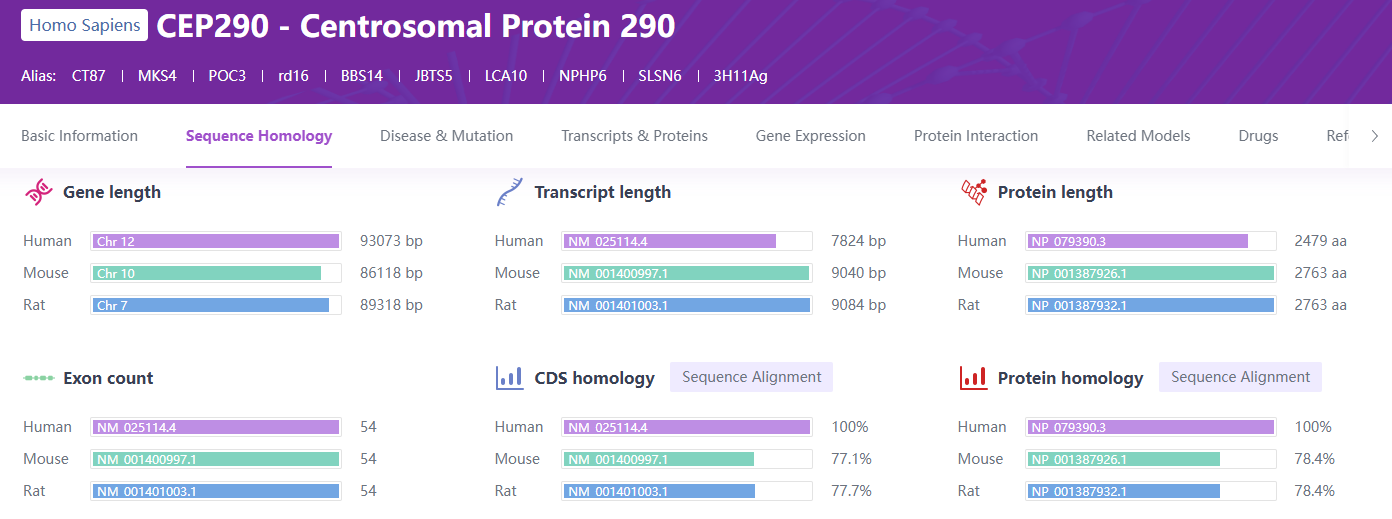

Catalog Number: I001217
Strain Name: C57BL/6JCya-Cep290tm1(hCEP290)/Cya
Genetic Background: C57BL/6JCya
One of Cyagen's HUGO-GT™ (Humanized Genomic Ortholog for Gene Therapy) Strains
Strain 설명
Leber Congenital Amaurosis (LCA), also known as hereditary congenital retinal dystrophy or Alström-Olsen syndrome, is a severe, hereditary, blinding retinal dystrophy, accounting for approximately 5% of all inherited retinal diseases. This condition has an estimated global prevalence of 1 in 80,000 to 1 in 30,000, with rapid vision loss typically beginning in infancy. LCA is the earliest and most severe genetic retinal disorder, characterized by the complete loss of cone and rod photoreceptor function within the first year of life, leading to congenital blindness. This disorder is inherited in an autosomal recessive manner, with 17 distinct subtypes identified to date. Among them, LCA10 is the most prevalent, with mutations in the CEP290 gene recognized as a primary causative factor. The CEP290 gene encodes the centrosomal protein CEP290, which is localized at the basal body of photoreceptor cells and plays an essential role in ciliary formation, stability, and transport. This protein is positioned within the ciliary transition zone of cone and rod photoreceptors, where it is crucial for primary cilia formation and stability, mediating the trafficking of ciliary proteins between the inner and outer photoreceptor segments. Mutations in CEP290 are associated not only with LCA10 but also with other ciliopathies, including Joubert syndrome and nephronophthisis; antibodies against this protein have been linked to various cancers.
Current therapeutic strategies targeting CEP290 predominantly focus on gene therapy, including antisense oligonucleotides (ASO), CRISPR gene editing, and adeno-associated virus (AAV) delivery. In the development of these therapeutic approaches, humanized mice serve as critical preclinical models. Given the genetic differences between mice and humans, humanizing the mouse Cep290 gene facilitates the evaluation of CEP290-targeted therapies in a model more representative of human physiology, expediting the translation of these therapies into clinical stages. This strain is is a humanized mouse model of Cep290, in which the endogenous mouse Cep290 gene is replaced by the human CEP290 gene using gene-editing technology. It can be used to study Leber Congenital Amaurosis type 10 (LCA10). In addition, based on the independently developed TurboKnockout fusion BAC recombination technology, Cyagen can also generate mutation models based on this strain and provide customized services.
Strain 유전자 편집 전략

Figure 1. Gene editing strategy of B6-hCEP290 mice. The exons 7-52 and flanking sequence of the mouse Cep290 was replaced with the entire human CEP290 gene plus ~30 kb of the human CEP290 promoter, and the human sequence was inserted in reverse to prevent disruption of Tmtc3 gene function.
응용 분야
검증 데이터
1. Normal retinal morphology in B6-hCEP290 mice

Figure 2. Fundus morphology and OCT results of WT and heterozygous B6J-hCEP290 mice. The fundus morphology and retinal OCT results of heterozygous B6J-hCEP290 mice were consistent with those of WT.
2. Normal retinal photoreceptor function in B6-hCEP290 mice

Figure 3. Electroretinogram (ERG) detection results of WT and B6J-hCEP290 mice. Compared with WT, the amplitudes of the a-wave and b-wave in both scotopic and photopic ERG recordings of heterozygous B6J-hCEP290 mice were nearly identical to those of the WT. The retinal photoreceptor function of heterozygous B6J-hCEP290 mice was normal.
추가 정보: The Rare Disease Data Center (RDDC)
1. Basic information about the CEP290 gene

https://rddc.tsinghua-gd.org/gene/80184
2. CEP290 clinical variants

3. Disease introduction
Leber Congenital Amaurosis (LCA), also known as hereditary congenital retinal dystrophy or Alströem-Olsen syndrome, is a severe hereditary blinding retinal dystrophy, accounting for about 5% of all hereditary retinal diseases. Its global prevalence is estimated to be between 1 in 80,000 and 1 in 30,000, characterized by rapid vision loss after birth. LCA is the earliest and most severe genetic retinal disorder, with patients losing both cone and rod cell function within the first year of life, leading to congenital blindness in infants. It is an autosomal recessive genetic disorder. There are 17 types of LCA, with LCA10 being the most common. Mutations in the CEP290 gene are a major cause of LCA10.
4. CEP290 gene and mutations
The CEP290 gene encodes the centrosomal protein 290, located at the basal body of the photoreceptor cells connecting the cilia, and is responsible for the formation, stability, and transport function of cilia. This protein is located in the ciliary transition zone of cone and rod photoreceptors and is critical for the formation and stability of primary cilia, regulating the trafficking of ciliary proteins between the inner and outer segments of photoreceptors. Mutations in the CEP290 gene are associated with Joubert syndrome and nephronophthisis, and antibodies against this protein are related to various cancers. Mutations in the CEP290 gene are distributed in both exons and introns, with the most common mutation being the intronic nonsense mutation c.2991+1655A>G [1].
5. Function of non-coding DNA sequences
Intronic point mutations in the CEP290 gene are relatively common, especially c.2991+1655A>G.
6. CEP290-targeted gene therapy
The pipelines targeting CEP290 are all related to gene therapy, including ASO, CRISPR, AAV, etc. Humanized mice have been widely used during the development of the drug pipeline. For example, Editas’ pipeline EDIT-101 delivers the gene encoding the Cas9 nuclease variant SaCas9 and two guide RNAs (gRNAs) to photoreceptor cells to remove the aberrant splice donor generated by the CEP290 IVS26 c.2991+1655 A>G mutation, thereby restoring normal splicing between exons 26 and 27. The CEP290 humanized mice were used to evaluate the subretinal efficacy response of EDIT-101 [2-3].
7. Summary
The CEP290 gene is an important pathogenic gene in Leber congenital amaurosis type 10 (LCA10). The mouse Cep290 humanized model and mutant models built on this strain from Cyagen can be used for preclinical research on gene therapy for LCA10. Furthermore, Cyagen can provide customized services for different point mutations of the CEP290 gene.
참고 문헌